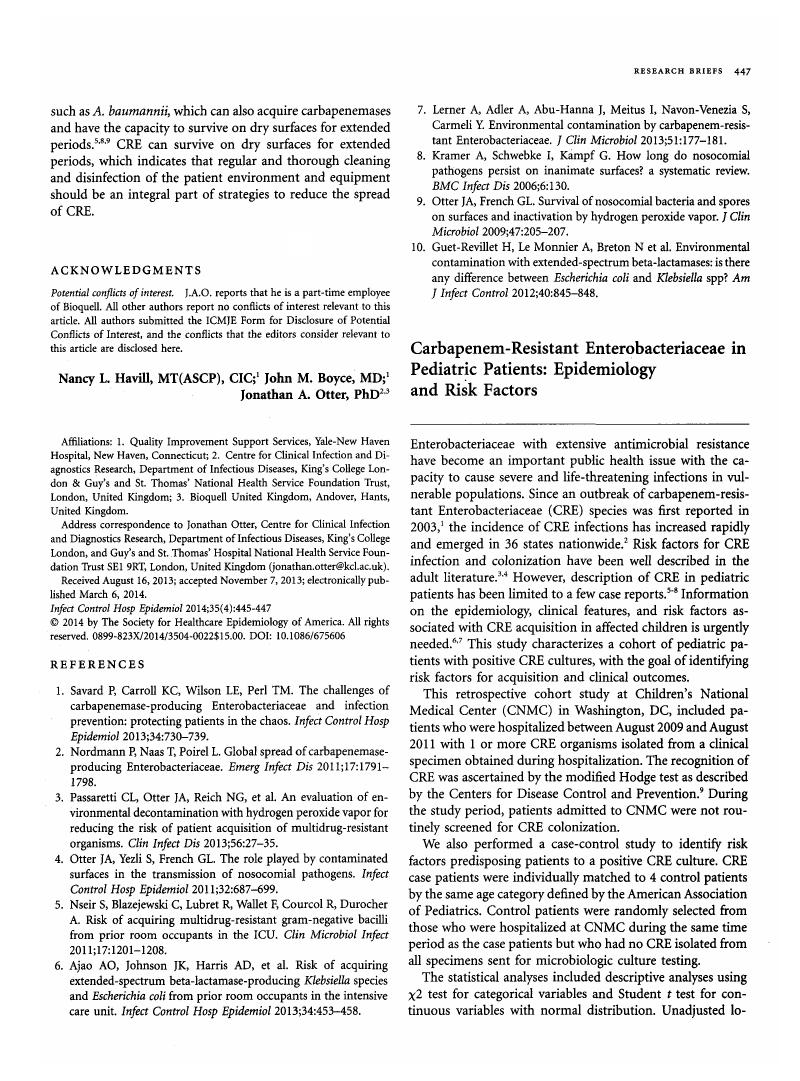Crossref Citations
This article has been cited by the following publications. This list is generated based on data provided by Crossref.
Moodley, Prashini
and
Whitelaw, Andrew
2015.
The Pros, Cons, and Unknowns of Search and Destroy for Carbapenem-Resistant Enterobacteriaceae.
Current Infectious Disease Reports,
Vol. 17,
Issue. 6,
Montagnani, Carlotta
Prato, Manuela
Scolfaro, Carlo
Colombo, Sara
Esposito, Susanna
Tagliabue, Claudia
Lo Vecchio, Andrea
Bruzzese, Eugenia
Loy, Anna
Cursi, Laura
Vuerich, Marco
de Martino, Maurizio
and
Galli, Luisa
2016.
Carbapenem-resistant Enterobacteriaceae Infections in Children.
Pediatric Infectious Disease Journal,
Vol. 35,
Issue. 8,
p.
862.
Chiotos, Kathleen
Han, Jennifer H.
and
Tamma, Pranita D.
2016.
Carbapenem-Resistant Enterobacteriaceae Infections in Children.
Current Infectious Disease Reports,
Vol. 18,
Issue. 1,
Díaz, Alejandro
Ortiz, Diana Cristina
Trujillo, Mónica
Garcés, Carlos
Jaimes, Fabian
and
Restrepo, Andrea Victoria
2016.
Clinical Characteristics of Carbapenem-resistant Klebsiella pneumoniae Infections in Ill and Colonized Children in Colombia.
Pediatric Infectious Disease Journal,
Vol. 35,
Issue. 3,
p.
237.
Chiotos, Kathleen
Tamma, Pranita D.
Flett, Kelly B.
Naumann, Matthew
Karandikar, Manjiree V.
Bilker, Warren B.
Zaoutis, Theoklis
and
Han, Jennifer H.
2017.
Multicenter Study of the Risk Factors for Colonization or Infection with Carbapenem-Resistant Enterobacteriaceae in Children.
Antimicrobial Agents and Chemotherapy,
Vol. 61,
Issue. 12,
Siegel, Jane D.
and
Guzman-Cottrill, Judith A.
2018.
Principles and Practice of Pediatric Infectious Diseases.
p.
10.
Logan, Latania K.
Nguyen, David C.
Scaggs Huang, Felicia A.
Qureshi, Nadia K.
Charnot-Katsikas, Angella
Bartlett, Allison H.
Zheng, Xiaotian
Hujer, Andrea M.
Domitrovic, T. Nicholas
Marshall, Steven H.
Bonomo, Robert A.
and
Weinstein, Robert A.
2019.
A Multi-Centered Case-Case-Control Study of Factors Associated With Klebsiella pneumoniae Carbapenemase-Producing Enterobacteriaceae Infections in Children and Young Adults.
Pediatric Infectious Disease Journal,
Vol. 38,
Issue. 5,
p.
490.
Murray, Meghan T.
Beauchemin, Melissa P.
Neu, Natalie
and
Larson, Elaine L.
2019.
Prior antibiotic use and acquisition of multidrug-resistant organisms in hospitalized children: A systematic review.
Infection Control & Hospital Epidemiology,
Vol. 40,
Issue. 10,
p.
1107.
Ogunbosi, Babatunde O.
Moodley, Clinton
Naicker, Preneshni
Nuttall, James
Bamford, Colleen
Eley, Brian
and
Arshad, Mehreen
2020.
Colonisation with extended spectrum beta-lactamase-producing and carbapenem-resistant Enterobacterales in children admitted to a paediatric referral hospital in South Africa.
PLOS ONE,
Vol. 15,
Issue. 11,
p.
e0241776.
Aguilera-Alonso, David
Escosa-García, Luis
Saavedra-Lozano, Jesús
Cercenado, Emilia
and
Baquero-Artigao, Fernando
2020.
Carbapenem-Resistant Gram-Negative Bacterial Infections in Children.
Antimicrobial Agents and Chemotherapy,
Vol. 64,
Issue. 3,
Li, Zhe
Lin, Xi-Xi
Liu, Cai-Xia
Ye, Wen-Jing
Liu, Pei-Ning
Li, Hai-Yan
and
Dong, Lin
2020.
Epidemiological characteristics and risk factors of nosocomial carbapenem-resistant Enterobacteriaceae infections in children.
Chinese Medical Journal,
Vol. 133,
Issue. 22,
p.
2756.
Schaps, Diego
Leraas, Harold J.
Rice, Henry E.
and
Tracy, Elisabeth T.
2022.
Surgical Site Infection in Children with Neuromuscular Disorders after Laparoscopic Gastrostomy: A Propensity-Matched National Surgical Quality Improvement Program Pediatrics Database Analysis.
Surgical Infections,
Vol. 23,
Issue. 3,
p.
226.
Komitopoulou, Anna
Paisiou, Anna
Oikonomopoulou, Christina
Kaisari, Katerina
Ioannidou, Eleni D.
Tzannou, Ifigeneia
Sipsas, Nikolaos V.
Vessalas, George
Peristeri, Ioulia
Goussetis, Evgenios
and
Kitra, Vasiliki
2022.
Is Carbapenem-resistant Klebsiella pneumoniae Infection in Pediatric Bone Marrow Transplantation Recipients Inevitably Fatal?.
Journal of Pediatric Hematology/Oncology,
Vol. 44,
Issue. 2,
p.
e456.
Micozzi, Alessandra
Luise, Cristina
Lisi, Chiara
Moleti, Luisa
Santilli, Stefania
and
Gentile, Giuseppe
2024.
Benefits and Safety of Empiric Antibiotic Treatment Active Against KPC-Producing Klebsiella pneumoniae for Febrile Neutropenic Episodes in Colonized Children with Acute Leukemia—An 8-Year Retrospective Observational Study.
Antibiotics,
Vol. 13,
Issue. 11,
p.
1017.



